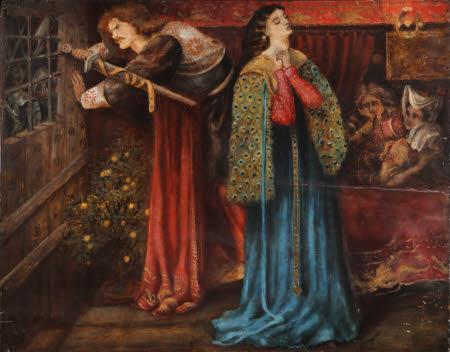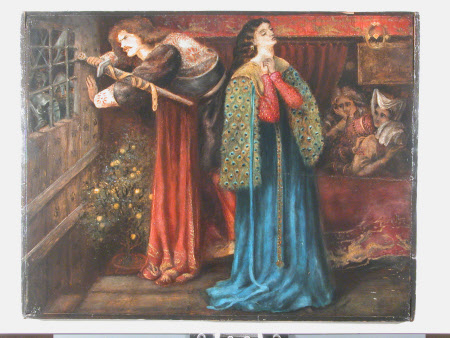Sir Launcelot in the Queen's Chamber
Henry Treffry Dunn (Truro 1838 - 1899)
Category
Art / Oil paintings
Date
circa 1896 - circa 1898
Materials
Oil on panel
Measurements
355 x 460 mm
Order this imageCollection
Wightwick Manor, West Midlands
NT 1288987
Caption
This painting is a panel from a bed decorated with paintings by Dunn for Theodore Watts-Dunton. The subject, taken from the ‘Morte d' Arthur’, and the treatment are closely linked to Rossetti's designs for the murals in the Oxford Union Debating Hall. There is a drawing by Rossetti of 1857 (now in the Birmingham City Art Gallery), that is inscribed on the frame: “How Sir Launcelot was espied in the Queen's Chamber, and how Sir Agravaine and Sir Mordred came with twelve knights to slay him.” In 1867, Dunn had become Rossetti’s studio assistant, eventually becoming his unofficial secretary, manager of his household and companion. His duties included painting and drawing to assist the production of finished pictures, and making replicas. Rossetti wrote to him: “You are the best of fellows and my guardian angel.” In the mid 1890s, Dunn, by then penniless and in poor health, found work and lodgings with Watts-Dunton.
Summary
Oil painting on panel, Sir Launcelot in the Queen's Chamber by Henry Treffry Dunn (Truro 1838 - 1899), circa 1896-98. A panel from the folding bed cupboard (WIG/F/160) showing a man, Sir Launcelot, wearing a red cloak and a woman, Guinevere, wearing a peacock cloak. He pushes the hilt of his sword against a barred window, where soldiers can be seen, whilst she raises her hands in prayer. Behind her are three dispairing women behind a partially drawn curtain on the right, a lemon tree on the floor to the left. The subject is from Sir Thomas Malory's Morte d'Arthur. The painting has been copied from a drawing by Rossetti now in Birmingham City Art Gallery which was originally inscribed: "How Sir Launcelot was espied in the Queen's Chamber, and how Sir Agravine and Sir Modred came with twelve knights to slay him."
Full description
Dunn was born in Truro. His father, a tea and spice merchant, found him a job in a bank, but Dunn eventually abandoned this and moved to London to study at Heatherley's art school. In 1867 he became Rossetti's studio assistant, gradually becoming his unofficial secretary, manager of his household and companion between then and 1881. His duties included painting and drawing to assist the production of finished pictures and making replicas, obtaining materials, props, models etc. Rossetti wrote "You are the best of fellows and my guardian angel." After Rossetti's death in 1882 Dunn completed some unfinished Rossetti works and helped William Michael Rossetti clear the house. He tried unsuccessfully to pursue a career as an independent artist, renting his own studio and exhibiting. He began drinking heavily, damaging his health. By 1892 he was reduced to painting furniture in a second-hand shop in the Kings Road. In the mid 1890s, penniless and ill, he sought help from Rossetti's friend Theodore Watts-Dunton at 2 The Pines, Putney. Watts-Dunton, who had already given a home to the poet Swinburne, provided Dunn with a studio and materials at The Pines and lodgings nearby. He spent the remainder of his life painting, often subjects suggested by Watts-Dunton. The painting is a panel from the bed (see under Painted Furniture) decorated with paintings by Dunn for Theodore Watts-Dunton, No. 2 The Pines, Putney. It is inspired by Rossetti's ink drawing (Surtees No. 95) done in Oxford in 1857 (now in Birmingham City Art Gallery). The subject from the Morte d' Arthur and the treatment are closely linked with Rossetti's designs for the murals in the Oxford Union Debating Hall which he was working on at the time. The original drawing is inscribed on the frame "How Sir Launcelot was espied in the Queen's Chamber, and how Sir Agravaine and Sir Mordred came with twelve knights to slay him". (adapted from author's unpublished property catalogue, Stephen Ponder, Wightwick Manor, circa 1995)
Provenance
Bed cupboard made for Thoedore Watts-Dunton; Clara Watts-Dunton; sale of contents of 2, The Pines, Sotheby's 22 March 1939, purchased as part of the bed by Frank Tilley; sold by him to Geoffrey Mander April 1939
Marks and inscriptions
Verso: 'Prepared panel Winsor & Newton'
Makers and roles
Henry Treffry Dunn (Truro 1838 - 1899), artist

